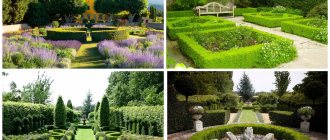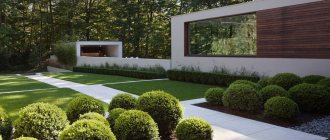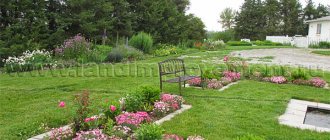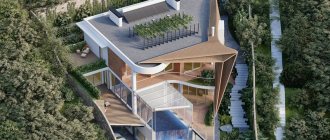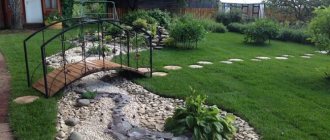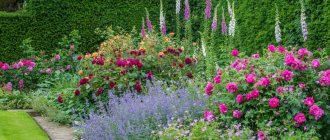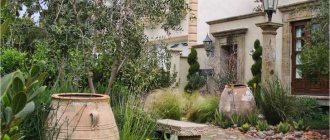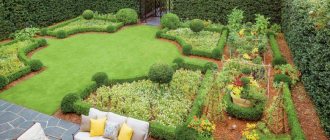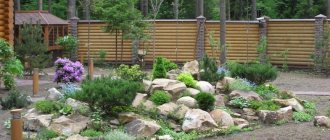The regular or formal style of landscape design is closely associated with the name of King Louis XIV and it reached its heyday in France in the 17th century, during the apogee of absolutism, so it is not surprising that it is also commonly called the French style.
Thoughtfulness, clarity, and precision of design down to the smallest detail has become a unique symbol of the triumph of beauty and order over chaos, the genius of the human mind over the forces of nature, conquest, superiority and power over the surrounding world. Regular gardens and parks, due to their compositional complexity, were primarily used to decorate castles and palaces, where they were supposed to further emphasize the monumentality and splendor of architectural ensembles. A great contribution to the formation and development of the regular style was made by the court gardener of Louis XIV, Andre Le Nôtre, who became the author of unique landscape creations in the famous parks of Chantilly, Vaux-le-Vicomte, Fontainebleau, and in the park of the Palace of Versailles. It represents nothing more than a person’s desire to streamline and organize everything rationally. Most often, compositions built on a site in a regular style resemble a strict and consistent conservative ornament, in which one part is a reflection of the other according to the rule of symmetry. Here the main concepts are rigor and refinement of appearance, as well as some orderliness, which is achieved through symmetry. Symmetry can be made from the house (where the building is the reference point) or from another design element, where it will be taken as 0. Here, the ground floor can also be taken as the reference point in the center, that is, from French, an element close to the ground . It could be anything, for example, a flower bed, a fountain, a pond, or just a lawn. The person decides here.
Nowadays, it is extremely difficult to find a clean, regular style. As a rule, the formal style is used to decorate a separate section of the garden or they borrow only the brightest and most interesting elements from it, harmoniously fitting them into gardens of other styles. This is due not only to fashion, but primarily to the labor-intensive and costly process of creating a regular garden. The formal style is a celebration of wealth, perfection and grandeur, which is inherent in classical architecture, so it will be the best decoration for mansions built in antique style, with balustrades, terraces, and rich sculptural elements. In the symmetrical layout of regular gardens, the correct proportions and shapes of majestic ancient buildings are clearly visible.
Layout
The French, or regular, style is characterized by neat, strictly symmetrical compositions made in the form of various geometric shapes. Moreover, both in the basic construction and in the details there is a law that determines the order and power of man over the wild surrounding nature. Most compositions are created over large areas and in one plane. This technique, called “parterre,” implies a quadrangular lawn, in the center of which there is a flower bed, a small pool with a fountain or a sculpture with branching paths. The ground floor is surrounded by a border of neatly trimmed evergreens such as cypress, conical spruce, pyramidal poplar and other low-growing trees with a dense geometric crown.
The ideas of pomp, grandeur and formality characteristic of the French style require a visual expansion of space, which is achieved through flat terrain and a system of long and wide paths and alleys, decorated on both sides with ornamental shrubs. Alleys paved with broken bricks or river pebbles can run parallel to each other or intersect, but must necessarily converge at the house as the central object of the composition. The French garden has two key points - the upper one, where the house is located, and the lower one with the main entrance. This arrangement is not accidental. In the old days, it was created in order to amaze guests with the pomp and grandeur of the entire composition. Along with pomp and theatricality, the French style is characterized by rationality and clarity of lines, therefore a clearly defined main axis divides the space into two absolutely symmetrical parts, the elements of which are subordinated to strict and precise forms.
One of the interesting elements is the labyrinths, which are thickets of juniper, honeysuckle or hazel with paths stretching over a large area. Shrubs for labyrinths require a mandatory geometric pruning. However, all the shrubs, trees and ponds of the French garden are distinguished by their strict geometric shape. A decorative pond with fountains and water cascades or an antique sculpture located in the center of the garden looks very elegant and stylish.
A distinctive feature of landscape design in the French style is the bosquet. This is a closed space with a geometrically regular shape. On all sides the bosquet is bordered by evenly trimmed and frequently planted acacia, hawthorn, Tatarian maple, spruce or currant trees. The interior space, called the green room or office, is decorated with a lawn or densely planted perennial plants. Between the bosquets there are neat paths covered with small granite or river pebbles.
Most often, the panorama of a French garden unfolds in one landscape plane. For landscapes with differences in elevation, level areas with spacious terraces are created, which are connected by stairs. To add truly French charm, terraces can be decorated with parterres and bosquets. The fencing for a French garden can be a hedge in which there are special niches with garden furniture in light colors. In the far part of the garden, in the place where the ground floor with intersecting paths is located, it would be nice to install an elegant and cozy gazebo designed for relaxation.
Using a French garden layout would be appropriate if a country cottage or mansion is intended to receive such guests who need to be amazed by elegance, prosperity and a sense of taste. However, it must be taken into account that creating a park or garden in a formal style requires a fairly large space, a poorly defined terrain and the continuous work of a professional gardener to plant and improve it. A park or garden made in the French style has, first of all, the main axis of the entire architectural layout, and the arrangement of elements must be symmetrical. This will be the main idea of the style. The main entrance to such a garden should be located in the lower part, so that right from the entrance one can appreciate all the greatness and superiority of the composition.
In the usual layout, a park or garden is laid out in front of the building's facade, in the center of which, as a rule, there is a fountain or sculpture. This arrangement very advantageously emphasizes the perspective of the space, visually enlarging it. It is best if the plants that predominate are those that retain their shape for a long time and are easy to trim. They can be either coniferous or deciduous. In Belarus, plants such as spruce, thuja, hawthorn, spirea, maple, apple, plum, linden, barberry, privet, and cotoneaster are best suited for this purpose. Alleys of these trees and shrubs should be wide, spacious and always straight. The central alley, leading directly to the mansion, is planted with one type of tree. The remaining alleys, coming from the central one, can intersect at right angles, or diverge from the main alley in rays. All trees, shrubs, flower beds and lawns, in order to maintain their geometric shape, must be trimmed promptly and regularly, which requires time and effort, and in the absence of such, significant financial costs, which once again emphasizes the wealth of the owner. If the area of the park allows, then a “green labyrinth”, which usually consists of bushes and paths, can become a very interesting element of the French style. To create such a labyrinth, it is convenient to use juniper or honeysuckle, and line the paths with small pebbles or crushed bricks.
This style does not require a fence for a park or garden. Previously, ditches with water were used as fencing, which did not visually limit the space. They have been replaced by elegant wrought-iron trellises or hedges, in special niches of which garden furniture in pastel colors looks very beautiful. The part of the park located behind the mansion is usually designed in a free style. It is very convenient to place a beautiful, cozy gazebo for relaxation here.
In order for a regular style garden to retain its attractiveness for a long time, constant and careful care is required. Most often, this style is used to decorate government residences, government buildings, hotels, theaters and museums. In addition to public institutions, the French style can be used for landscaping country houses, driveways and pedestrian paths. In order not to disturb the harmony and the basic idea inherent in this style, it is necessary to preserve its traditions and, when designing, take into account the correspondence of the architectural style to the residential building.
Story
In the middle of the 16th century, new gardens were laid out on the slopes of Boboli Hill in Florence, at the residence of the Medici Dukes. They were cherished for a long time, embodying time-tested aesthetic theses and completely new ideas. For example, thanks to specially equipped elevations, for the first time in the history of landscape art, a view of the city opened from the park.
Florentine gardens became the quintessence of everything that not only gardeners, but architects and sculptors had created before. There were wide gravel alleys and long axial paths, oaks, cypresses, lemon trees in tubs, roses and lilies in huge flower beds... And also an amphitheater, where opera arias were heard for the first time in the world, colonnades and terraces, man-made ponds with islands, fountains and grottoes, artifacts from Greece and ancient Egypt.
It was impossible not to notice the Boboli Gardens. Andre Le Nôtre, a hereditary master of landscaping, court gardener of Louis XIV (it is known that the French monarch was very keen on the art of gardening), created a project for the Versailles park, taking the Boboli gardens as a basis.
The style that emerged as a result stunned and captivated Europe. Parks in a regular style began to appear in England, Spain, Austria, Russia... However, Versailles remained an absolute, like a pure diamond, standard of regularity.
Versailles
The gardens near the Palace of Versailles took almost 40 years to form. Master Le Nôtre pursued a technically complex, ambitious goal: to create the illusion of infinity, the vastness of the landscape, and also to prove, with the help of technical tricks, that the French king ruled not only over his subjects, but also over nature.
Well, Le Nôtre succeeded. The gardens of Versailles remain the standard of measurement even today when it comes to regular style. All other parks, by default, repeat the clichés set by master Le Nôtre.
The first among them is scale. Louis XIV loved fresh air, sun and wind, long walks, and did not tolerate the crowded and constricted streets of Paris. Of course, this was taken into account when creating the Versailles ensemble. As a result, the royal gardens spread over a huge territory, completely unimaginable for that era - an area of 8,300 hectares. Their green tablecloth extended from east to west, as if following the sun. In the morning, its first rays illuminated the Hall of Glory, awakened the palace, looked into the royal chambers... And faded at sunset at the Mirror Gallery. The sun, the personal symbol of the French monarch, also became the symbol of Versailles and its incredible, stunning gardens.
On what principles, calculations and secrets was this effect based?
Choosing plants in a formal garden
The concept of the French regular style in garden design is based on strict geometry, and therefore plants for such gardens are selected so that they are well trimmed, easily take the correct shape, and are resistant to disease.
First of all, these are evergreen species that can look well-groomed and attractive throughout the year. In gardens of the French regular style you can often see monogardens - areas in which plants of the same species are cultivated, which determines the name of the monogarden: it can be a rose garden, an iridiary, a sirengarium, etc. It is impossible to imagine a “French garden without topiaries - figuredly trimmed trees and shrubs. Also obligatory elements for it are parterre lawns and parterre flower beds or, as they are also called, arabesque flower beds.
To form smooth and neat borders, yew and boxwood are usually used. Boxwood is easy to trim and is capable of maintaining even the most bizarre shapes for a long time. Yews are famous for their exceptional longevity, have dense crowns with whorled branches, love moist air, good sunlight and fresh soil saturated with lime.
Of the shrubs, first of all you should pay attention to privet, which is represented by both deciduous and evergreen shrubs. As a rule, they are sun-loving, grow well on ordinary garden soil, perhaps even with the addition of lime, but have difficulty withstanding wet, heavy clay with an acidic reaction. In French regular style gardens, it is preferable to plant common privet - a deciduous, densely branched shrub up to 5 m high, growing quickly and able to withstand temperatures down to -30°C in winter.
The second place in popularity among plants for gardens of the French regular style, adapted to Belarusian realities, is occupied by small-leaved linden (or cordate linden) - the most resilient representative of broad-leaved species. This plant can tolerate frosts down to -48°C in winter. The maximum possible growth level for the small-flowered linden is 30 m. It has a compact oval crown and a slender cylindrical trunk. Linden is shade-tolerant, not too demanding on soil quality, but does not tolerate drought. It grows relatively quickly and is ideal for forming a hedge.
Non-thorny shrubs such as cotoneaster would also look quite appropriate in a French regular style garden. In landscape design, more than eighty types of hedges are traditionally used to form hedges.
It is impossible not to mention the common barberry, to which people gave the name “candy tree” for the pleasant delicate aroma of ripe berries. But in fact it is a thorny deciduous shrub. Forming a barberry hedge can take quite a long time - at least six years, but all the efforts will be justified in the end. In spring, the bushes are covered with golden flowers, in autumn they attract attention with the bright purple leaves. Among the varieties with intense lateral branching that are optimally suited for the formation of hedges and borders, in addition to the common barberry, it is necessary to note the Thunberg barberry, Siberian barberry and Ottawa barberry.
Of the trees, in addition to the already mentioned and extremely popular linden, in the French regular style garden you can plant maples of the campestrie type, a typical representative of which is the field maple, as well as ornamental apple trees and ornamental plums.
The field maple has a spherical crown and reaches a height of 15 m. The maple is shade-tolerant, resistant to drought and can withstand slight soil salinity. It grows quite slowly, but easily tolerates transplanting and cutting. As for ornamental apple trees, the most popular varieties adapted to the climatic conditions of Belarus are, perhaps, “Royalty” and “Everest”. 'Royalty' has red-purple leaves, bright pink flowers and small dark red fruits. This apple tree is light-loving and frost-resistant, blooms, as a rule, no earlier than May, and reaches a height of 4-6 m. “Everest” has dark green, oval leaves, white flowers, a conical crown shape with drooping shoots. The yellow-red fruits of "Everest" look very decorative and may not fall until December. The tree is resistant to frost, but does not tolerate heat at all. The ornamental plum has a dense crown with shiny purple-red leaves, grows on fertile loams of medium humidity, preferring brightly sunny places. Can be used both in group and single plantings.
Coniferous plants in gardens designed in the traditions of the French regular style are rather an exception to the rule, but in cases where climatic conditions do not allow planting it with the necessary deciduous species, and you really want to have such a garden, experiments with conifers are not forbidden. The most suitable decorative forms are gray spruce (there are about 20 of them in total), prickly spruce, thuja and cypress trees.
Unpretentious and flexible to any design experiments, thuja occidentalis has gained fame as a universal landscaping product. It also does not contradict the canons of the French regular style. Landscape designers know more than twenty varieties of thuja occidentalis, and among them they often give preference to the variety “Brabant” - a plant with green shoots and yellow tips and dynamic growth rates - up to half a meter per year. The maximum height of the thuja variety "Brabant" rarely exceeds 8 m. Two crown trimmings are enough to turn it into an impenetrable wall.
The thuja variety "Smaragd" has a beautiful cone-shaped crown and bright green needles that retain their rich color all year round. It usually grows to 1-2 m in width and up to 8 m in height, just like the thuja variety "Brabant". Thuja “Smaragd” does not tolerate waterlogging, and this care feature must be taken into account. Speaking about the selection of plants for a French regular style garden, it is worth mentioning such a variety of western thuja as the dwarf “Danika” - a spherical shrub up to 0.6 m high. It maintains the correct spherical shape throughout its entire life period, requiring no pruning at all.
Parterre lawns
Parterre lawns (link to article) in French regular style gardens should be covered with an even, silky and thick grass cover, reminiscent of a soft fleecy carpet. This surface is created by low narrow-leaved grasses - red fescue, meadow grass, bentgrass. Either one type of grass is sown, or a mixture of two different types capable of forming a homogeneous grass stand. You will have to cut it up to twice a week so that the grass does not grow higher than 1 cm.
When arranging parterre flower beds and regular arabesque flower beds, flowers must be selected so as to ensure continuous flowering throughout the season. In early spring, bulbous plants - narcissus, tulip, crocus, scylla, as well as early flowering perennials - for example, liverwort and anemone will be appropriate for them. Flowers for summer: viola, daisy, aquilegia, iris, alyssum, marigold, calendula, petunia, salvia, and many others. In autumn, the splendor of regular flower beds and flower beds will be emphasized by roses, helenium, asters and dahlias.
Curbs
Very narrow, no more than 10–40 cm wide, stripes of flowers, the main purpose of which is to edge flower plantings or a lawn. The length of the curb depends on the length of the object around which it is laid.
Typically, a border is created from low-growing or groundcover plants (alissum, sedum, etc.) or low shrubs, such as boxwood (in the south) or mantle.
Forming smooth, clear boundaries of floral patterns, borders add completeness to the flower garden.
On the site, borders can be used to frame paths from the gate to the front entrance or in the garden.
Advice. A border that contrasts with the main plantings will look very nice. For example, patterns of lemon-yellow tagetis on a green lawn are bordered with black and red perilla.
Small architectural forms in a regular style
In the French style, bulky and massive furniture is inappropriate. There are only two options for selecting household items - elegant, light products with elegant forged legs and supports, light seats, or typical furniture in the style of street cafes and summer terraces of restaurants.
But gazebos, if the area is large enough to install them, especially light structures in a romantic style, are welcome. In addition to those allocated in the basic structure, be sure to use each area in the garden, be it an extension, the intersection of paths or their “blind” end, for arranging zones and corners for relaxation.
A special place in the aristocratic French style should be given to potted gardens. If in the Mediterranean style they are simply displayed on platforms, then the French style is more inventive. He suggests using ladders or original multi-level supports for potted displays, which will simultaneously make the most of the space and emphasize the thematic design. Typical plants for the French potted garden are geraniums. A collection of different varieties on the steps of a staircase or even on a stepladder installed in a corner near the terrace is real French “chic”. For potted gardens, only white and pink flowering plants can be used.
Several potted plants should definitely be installed in the recreation area. They should be on the table, next to every piece of furniture, under seats and table tops. True, you should not use individual plants planted in pots, but entire potted compositions. What kind of flower pots will be is not so important, but light and non-glossy materials are better suited for the French style; in particular, clay vessels are considered typical. Roses, boxwoods, olive trees, laurel, citrus fruits, pomegranate, and lantana can be used as potted plants.
In such a garden, you simply must install at least one classic garden sculpture, reminiscent of French castles and palaces. If you have a high wall in your garden, then install a large mirror on it or create a wall landscape with perspective, camouflaging the sides with climbing plants. Such a spectacular “reflection” or unexpected perspective will bring a feeling of spaciousness and peace to the garden.
Colonial Landscape Design
Colonial style dates back to the time when Europeans arrived in America and had to re-adapt not only to a new way of life, but also to a different climate. The style combines two different cultures: the colonialists and the aborigines.
The diversity of local flora and the multinationality of the colonialists led to a striking style, which is characterized by comfort and slight carelessness. Characteristic elements of a colonial garden: clear zoning, stone paving stones, sundials, fountains, symmetrical straight gravel paths between flowerbeds, a low white fence.
The obligatory gardening part of the site in the colonial style is an echo of how the first settlers, in addition to the decorative purpose, also attached practical significance to the garden.
French style ponds
An important element of the classic style is water. It is embodied in pools with fountains, cascades and wall fountains. The mirror surface of the water will fit perfectly with the overall composition. The pond on the site is made in the shape of a circle, oval, square, rectangle. The coastline must be clear; plants in the coastal zone are planted in strict order, in rows. On large areas, cascades are often created - multi-stage structures made of stone or concrete that serve to cascade streams of water. Fountains are also installed on the site, which can serve as the center of flower arrangements, for example. Here, too, everything is subject to the laws of geometry: reservoirs have a strictly symmetrical, most often rectangular shape.
general information
Landscape design can be considered a concept that has been known for quite some time. Previously, it was used when it came to decorating fairly large land areas or public areas, including parks. But today, in this regard, the situation has changed quite dramatically. For contemporaries, landscape design has become relevant in many cases. And first of all, specialists in this field are in demand among private owners who buy large areas of land to build a house on it.
Landscape design in such cases should be thought out very carefully so that every corner of the site is used. Many home gardens today contain interesting decorative items; from a design point of view, they are luxurious and rich. Modern landscape design styles allow you to turn areas into fashionable and original places. But in order to get such a wonderful garden, you need to invest a lot of serious work and costs, including not only financial, but also time. The specialist must first decide on the style, install an irrigation system, select materials for paving paths, plants, fencing and much more. The correct approach to the design of the territory is the key to ensuring that the personal plot will turn out to be a truly unique place.
Materials and decorative elements in a regular style
The materials for a regular garden are chosen to be expensive, high quality - valuable wood, marble, ceramics, bronze. Accessories for a regular garden should also look rich, there should not be too many of them, but they should all favorably emphasize other elements of the garden and be “in place.” When decorating gazebos, wood carving and artistic forging are usually used. Fencing in a formal garden is cast iron or cast with a classic lattice pattern. In a formal garden, preference is given to calm tones, classic ornaments, and plant motifs.
Japanese landscape design
The Japanese garden is characterized by restrained purity of style, compositional precision and asceticism. No details of the landscape should distract from the contemplation of natural harmony or immersion in one’s own thoughts. The manner is based on Buddhist and Taoist philosophy.
Japanese style strives to create miniature copies of nature itself. This practice is an art form in the Land of the Rising Sun. Elements of a Japanese garden imitate or symbolize natural elements. The delicate combination of stones, calm or running water, and plants creates a special world.
The stylistic features of the Japanese-style garden design are the asymmetrical layout of the site, paths paved with stones, a natural pond, sand decorated with wave-like patterns and symbolic compositions made of natural stone.
Plums, maples, pines, cherries, bamboo, pine trees, willows, peonies, chrysanthemums, and bonsai are used for landscaping. The view created in a Japanese garden is far from real nature, but is based on it. Japanese gardens are not meant for walking, but for contemplation. When creating a Japanese-style garden, a sense of proportion and taste is important.
Mixborders
These are very fashionable and modern flower beds, including a wide variety of plants, as can be seen from the name, which is translated into Russian as “mixed border”.
Typically, mixborders occupy a fairly large area, where flowering changes several times throughout the growing season. Such flower beds are good throughout the entire season, and if coniferous crops (juniper, dwarf spruce and mountain pines) are included in the plantings, they are good all year round.
Plants for mixborders are selected based on the following factors: compatibility, growth rate, height, flowering time. It is also necessary to take into account the coloristic features of both individual groups and the entire flower garden as a whole. In this case, the area of each group is usually from 2 to 5 m2.
In addition, mixborders are used to frame paths, ponds and various architectural elements.
Advice. To make mixborders more decorative, it is recommended to include natural materials: colored pebbles, tree bark, wood chips, etc.
Modular flower beds
Despite their simplicity, such flower beds look very attractive. So, for example, you can revive a large tiled area, and in this case it is done very simply. They take out individual tiles and either add fertile soil and plant summer trees, or install suitable containers with blooming flowers.
You can do it differently. To do this, the area allocated for the flower garden is divided into regular elements of various geometric shapes. Some are planted with flowers (perennials and annuals), beautiful low shrubs or low coniferous crops, such as juniper or microbiota. The rest of the space is either sown with lawn grass, or covered with gravel, wood chips, etc.
Such flower beds can become a kind of “one-man show” if you plant flowers of the same species, but of different varieties, in modules, for example, gladioli or dahlias.
Rockeries
Rockeries, or rocky gardens, are most often located on rocky slopes, terraces or other areas where creating a flower garden of a different type is quite problematic.
However, most often you can find small artificial structures created from a pile of stones, called an alpine slide. In order for such structures to look good, they must, first of all, be natural; they must combine the beauty of rough stones and the tenderness and fragility of living plants into a single whole.
The size and placement of rockeries depend only on the conditions and capabilities of the area, but, as a rule, these are areas with an area of 2 to 200 m2 and a height of 0.5 to 10 m. Plants that prefer rocky soils, mostly low-growing and drought-resistant, are planted here. To give some picturesqueness to the entire structure, low-growing shrubs are planted; conifers, miniature roses and bulbous plants look especially good.
Advice. To create a rock garden, level the area and compact the soil. If you plan to place large stones (boulders), then pour concrete, otherwise they will gradually sag. Sandy soils are not suitable for rockeries.
Solitaires
Single plants that are used in both regular and landscape flower beds. Typically, a large flower or decorative foliage plant is chosen as a tapeworm. Low flowering shrubs, such as roses or spirea, also look good.
Typically, tapeworms are placed against the backdrop of a group of trees or a plain wall; they look good against retaining walls made of stone. However, it is necessary to coordinate the tapeworm with its surroundings, both in color and size. For example, with a retaining wall height of 1.5 m, a two-meter rose bush would hardly be appropriate as a tapeworm; canna, phlox, etc. would be more suitable here, and of course, such a plant should be carefully cared for.
Groups
This is a landscape style of planting, very common in our time, which is characterized by free outlines and smooth winding contours. The area of such plantings can reach from 3 to 60 m2, and most often the groups consist of perennials with a small proportion of annuals for annual renewal of the exhibition.
Groups can be divided into two subtypes - simple and complex. For simple groups , annual plants are selected so that flowering continues throughout the entire growing season. You can use the following combination: daffodils - lupins - phlox - asters. Such a group will look very attractive.
Complex groups are made up of plants of different species, combining perennial and annual flowers in height and color. A lot here depends on where the group is located. So, if it is visible from all sides, the tallest plants are planted in the center, and then the height is reduced towards the edges. However, if the group is located against a wall, then tall plants are placed in the background, leaving the front for short flowers. The use of tall plants such as delphinium, rose holly, etc. is very effective for group plantings.
